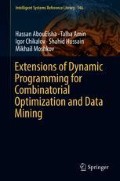Abstract
This chapter starts by formally defining the class of meshes under study. We describe the notion of element partition tree and present an abstract way of defining optimization criteria of element partition trees in terms of cost functions. A definition of a cost function is provided in addition to a few examples of cost functions under study along with some of their properties.
Access this chapter
Tax calculation will be finalised at checkout
Purchases are for personal use only
References
AbouEisha, H., Gurgul, P., Paszynska, A., Paszynski, M., Kuznik, K., Moshkov, M.: An automatic way of finding robust elimination trees for a multi-frontal sparse solver for radical 2D hierarchical meshes. In: Wyrzykowski, R., Dongarra, J., Karczewski, K., Wasniewski, J. (eds.) Parallel Processing and Applied Mathematics – 10th International Conference, PPAM 2013, Warsaw, Poland, September 8–11, 2013, Revised Selected Papers, Part II, Lecture Notes in Computer Science, vol. 8385, pp. 531–540. Springer (2013)
AbouEisha, H., Moshkov, M., Calo, V.M., Paszynski, M., Goik, D., Jopek, K.: Dynamic programming algorithm for generation of optimal elimination trees for multi-frontal direct solver over h-refined grids. In: Abramson, D., Lees, M., Krzhizhanovskaya, V.V., Dongarra, J., Sloot, P.M.A. (eds.) International Conference on Computational Science, ICCS 2014, Cairns, Queensland, Australia, June 10–12, 2014, Procedia Computer Science, vol. 29, pp. 947–959. Elsevier (2014)
Amestoy, P., Duff, I., L’Excellent, J.Y.: Multifrontal parallel distributed symmetric and unsymmetric solvers. Comput. Methods Appl. Mech. Eng. 184(2–4), 501–520 (2000)
Amestoy, P., Duff, I.S., L’Excellent, J., Koster, J.: A fully asynchronous multifrontal solver using distributed dynamic scheduling. SIAM J. Matrix Anal. Appl. 23(1), 15–41 (2001)
Amestoy, P., Guermouche, A., L’Excellent, J., Pralet, S.: Hybrid scheduling for the parallel solution of linear systems. Parallel Comput. 32(2), 136–156 (2006)
Amestoy, P.R., Duff, I.S., L’Excellent, J.Y.: MUMPS MUltifrontal Massively Parallel Solver Version 2.0. Research Report RT/APO/98/3 (1998). https://hal.inria.fr/hal-00856859
Bunch, J., Hopcroft, J.: Triangular factorization and inversion by fast matrix multiplication. Math. Comput. 28(125), 231–236 (1974)
Duff, I.S., Erisman, A.M., Reid, J.K.: Direct Methods for Sparse Matrices. Oxford University Press, New York (1986)
Duff, I.S., Reid, J.K.: The multifrontal solution of indefinite sparse symmetric linear systems. ACM Trans. Math. Softw. 9(3), 302–325 (1983)
Dwyer, P.S.: The Doolittle technique. Ann. Math. Stat. 12, 449–458 (1941)
Fialko, S.: A block sparse shared-memory multifrontal finite element solver for problems of structural mechanics. Comput. Assist. Mech. Eng. Sci. 16(2), 117–131 (2009)
Fialko, S.: The block subtracture multifrontal method for solution of large finite element equation sets. Tech. Trans. 1-NP(8) (2009)
Fialko, S.: PARFES: A method for solving finite element linear equations on multi-core computers. Adv. Eng. Softw. 41(12), 1256–1265 (2010)
Gall, F.L.: Powers of tensors and fast matrix multiplication. In: Nabeshima, K., Nagasaka, K., Winkler, F., Szántó, Á. (eds.) International Symposium on Symbolic and Algebraic Computation, ISSAC ’14, Kobe, Japan, July 23–25, 2014, pp. 296–303. ACM (2014)
Gurgul, P.: A linear complexity direct solver for h-adaptive grids with point singularities. In: Abramson, D., Lees, M., Krzhizhanovskaya, V.V., Dongarra, J., Sloot, P.M.A. (eds.) International Conference on Computational Science, ICCS 2014, Cairns, Queensland, Australia, June 10–12, 2014, Procedia Computer Science, vol. 29, pp. 1090–1099. Elsevier (2014)
Karypis, G., Kumar, V.: METIS-Serial Graph Partitioning And Fill-reducing Matrix Ordering. http://glaros.dtc.umn.edu/gkhome/metis/metis/overview (2012)
Okunev, P., Johnson, C.R.: Necessary and sufficient conditions for existence of the LU factorization of an arbitrary matrix. https://arxiv.org/pdf/math/0506382v1.pdf (1997)
Paszynska, A., Paszynski, M., Jopek, K., Wozniak, M., Goik, D., Gurgul, P., AbouEisha, H., Moshkov, M., Calo, V.M., Lenharth, A., Nguyen, D., Pingali, K.: Quasi-optimal elimination trees for 2D grids with singularities. Sci. Program. 2015, 303,024:1–303,024:18 (2015)
Yannakakis, M.: Computing the minimum fill-in is NP-complete. SIAM J. Algebr. Discret. Methods 2(1), 77–79 (1981)
Zhang, F. (ed.): The Schur Complement and Its Applications, Numerical Methods and Algorithms, vol. 4. Springer, New York (2005)
Author information
Authors and Affiliations
Corresponding author
Rights and permissions
Copyright information
© 2019 Springer International Publishing AG, part of Springer Nature
About this chapter
Cite this chapter
AbouEisha, H., Amin, T., Chikalov, I., Hussain, S., Moshkov, M. (2019). Element Partition Trees: Main Notions. In: Extensions of Dynamic Programming for Combinatorial Optimization and Data Mining. Intelligent Systems Reference Library, vol 146. Springer, Cham. https://doi.org/10.1007/978-3-319-91839-6_13
Download citation
DOI: https://doi.org/10.1007/978-3-319-91839-6_13
Published:
Publisher Name: Springer, Cham
Print ISBN: 978-3-319-91838-9
Online ISBN: 978-3-319-91839-6
eBook Packages: Intelligent Technologies and RoboticsIntelligent Technologies and Robotics (R0)

